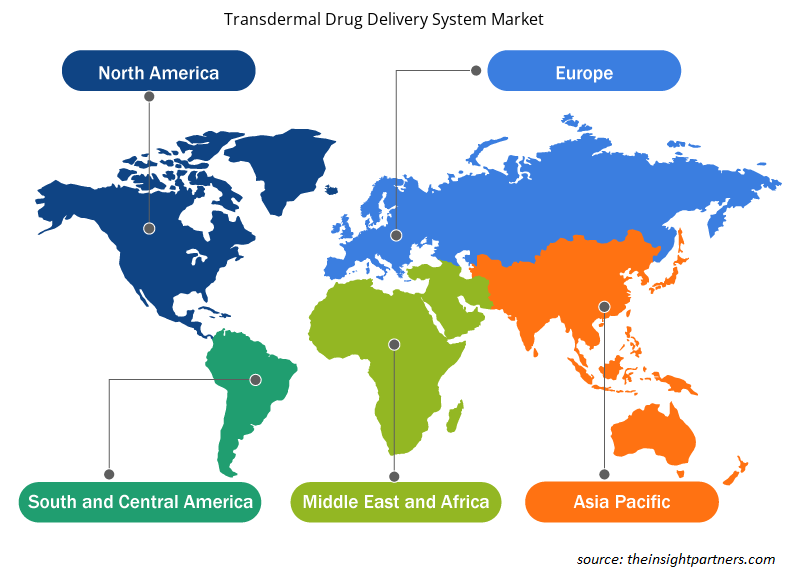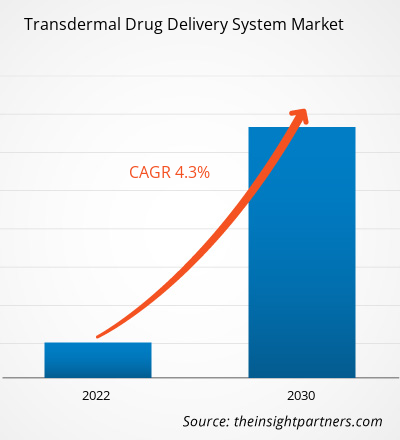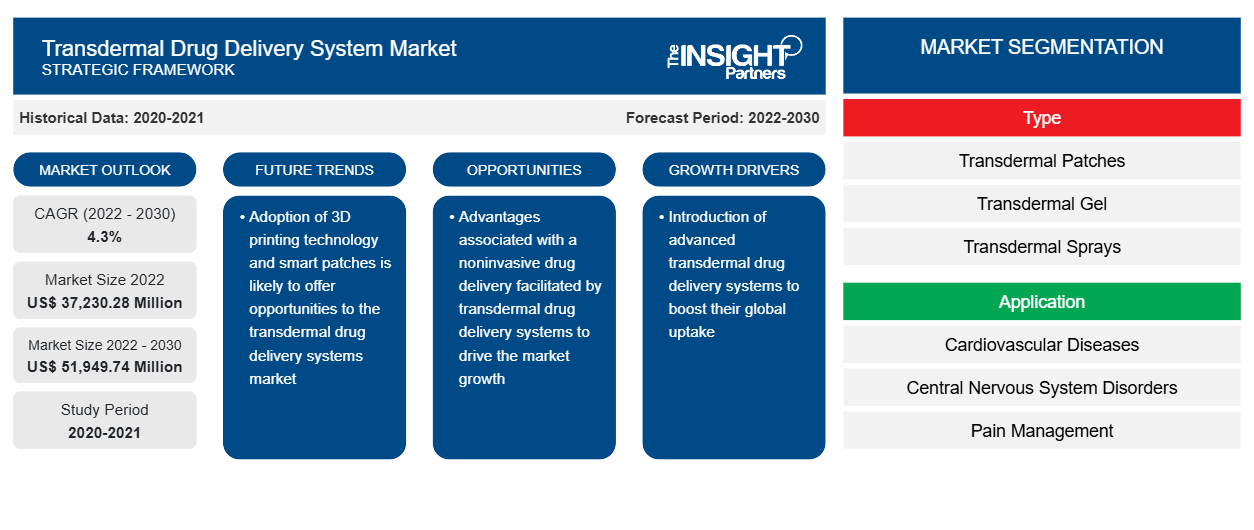透皮给药系统市场预计将从 2022 年的 372.3028 亿美元增长到 2030 年的 519.4974 亿美元;预计 2022 年至 2030 年的复合年增长率为 4.3%。制造商的战略举措可能仍将是市场的一个主要趋势。
透皮给药系统市场分析
慢性病发病率不断上升、对非侵入性药物输送设备的需求不断增长以及对自我用药的高需求是市场增长的主要驱动因素。此外,采用 3D 打印技术和智能贴片可能会在未来几年为透皮药物输送系统市场带来机遇。
透皮给药系统市场概览
心血管疾病 (CVD),如心绞痛、动脉粥样硬化、心力衰竭和急性心肌梗塞,是全球常见的死亡原因之一。根据世界卫生组织的数据,心血管疾病是全球每年约 1790 万人死亡的主要原因。市面上有许多用于治疗心血管疾病的药物,但传统的胶囊和药片无法有效控制疾病。这强调了对新型药物输送系统的需求,该系统可以提供更长的药物生物利用度,并将药物靶向输送到心血管系统的受影响区域。透皮药物输送系统在治疗心血管疾病方面比常规口服药物具有许多优势。透皮贴剂包含药物颗粒,可应用于皮肤表面。心脏贴剂为细胞植入改进提供了极好的平台。例如,最近开发的血管化心脏贴剂显示出治疗缺血性心脏损伤的良好潜力。硝酸甘油透皮贴剂用于预防冠状动脉疾病患者的心绞痛(胸痛)发作。它们的作用是放松血管,减少心脏压力,降低对氧气的需求。但是,这些贴片不能用于治疗已经开始的心绞痛。
定制此报告以满足您的需求
您可以免费定制任何报告,包括本报告的部分内容、国家级分析、Excel 数据包,以及为初创企业和大学提供优惠和折扣
-
获取此报告的关键市场趋势。这个免费样品将包括数据分析,从市场趋势到估计和预测。
透皮给药系统市场驱动因素和机遇
持续的技术进步
传统的药物输送技术,如肌肉注射、静脉注射和直肠给药,并不受特定患者群体的青睐,主要是因为这些技术会带来疼痛和复杂性。随着医学科学的进步和明确的药物输送技术,非侵入性药物输送系统现已准备好与传统的注射给药方法竞争。非侵入性药物输送系统包括口服、外用、透皮主动(设备辅助增强渗透)和透皮被动给药;吸入药物的透眼膜、透粘膜和肺泡膜。透皮给药在许多方面都优于口服给药途径。特别是,它避开了肝脏的首过机制,否则肝脏会冲动地代谢药物。
智能贴片和 3D 打印贴片的进步
透皮给药途径是一种新颖且可靠的持续给药方式之一。随着该领域的大量研究以及研究人员对这种给药方式的兴趣日益浓厚,许多透皮贴剂很可能在未来进入市场。透皮贴剂用于输送尼古丁、芬太尼、硝酸甘油和可乐定等药物,以治疗各种疾病。最近,这些贴剂已被探索用于在各种应用中输送生物制剂。智能贴片配备了传感器和其他技术,可监测患者状况并相应地调整药物输送。2023 年 1 月,斯旺西大学的一位首席科学家开发了一种新的智能贴片,使用微针技术检测帕金森病和阿尔茨海默病等神经退行性疾病的促炎生物标志物。这些智能贴片由许多微针组成,旨在以微创方式穿透皮肤屏障,然后监测具有临床意义的生物标志物。它们可以在全科医生或家中自行给药以进行即时诊断。这项创新研究可能会改变早期神经退行性疾病检测的格局。
透皮给药系统市场报告细分分析
有助于得出透皮给药系统市场分析的关键部分是产品和最终用户。
- 根据类型,透皮给药系统市场细分为透皮贴剂、透皮凝胶、透皮喷雾剂等。透皮贴剂部分在 2022 年占据了最大的市场份额。
- 根据应用,透皮给药系统市场分为心血管疾病、中枢神经系统疾病、疼痛管理、激素应用、其他应用。疼痛管理领域在 2022 年占据了最大的市场份额。
- 根据分销渠道,透皮给药系统市场分为医院药房、零售药房、网上药房等。医院药房部分在 2022 年占据了最大的市场份额。
透皮给药系统市场份额按地区分析
透皮给药系统市场报告的地理范围主要分为五个区域:北美、亚太、欧洲、中东和非洲、南美和中美。
美国是北美最大的透皮给药系统市场。根据美国心脏协会 (AHA) 的数据,心血管疾病 (CVD) 仍然是美国的主要死亡原因。根据 CDC 的数据,2021 年,CVD 导致约 695,000 人死亡,约占美国死亡人数的五分之一。心血管疾病、糖尿病、慢性疼痛和其他慢性疾病的患病率不断上升,推动了对有效和便捷治疗方案的需求。医疗贴片提供了一种非侵入性且对患者友好的方法来输送药物并控制与这些慢性病相关的症状。TDDS 的持续进步,例如可穿戴传感器和柔性电子产品,促进了透皮给药系统市场的增长。这些进步可以实现更准确的剂量、患者监测和依从性。根据《生物材料研究》2021年发表的一篇题为《透皮给药系统的最新进展》的报告,在透皮给药系统模式中,微针引起了极大的关注,它通过结合微针的优点来克服现有简单应用型和贴片型针的局限性,从而获得更高的治疗效率和效果。这些透皮给药系统的进展可以为控制心血管和中枢神经系统疾病、糖尿病、神经肌肉疾病以及传染性和局部性传染病的流行提供驱动力。
透皮给药系统市场区域洞察
Insight Partners 的分析师已详细解释了预测期内影响透皮给药系统市场的区域趋势和因素。本节还讨论了北美、欧洲、亚太地区、中东和非洲以及南美和中美洲的透皮给药系统市场细分和地理位置。

- 获取透皮给药系统市场的区域特定数据
透皮给药系统市场报告范围
| 报告属性 | 细节 |
|---|---|
| 2022 年市场规模 | 372.3028亿美元 |
| 2030 年的市场规模 | 519.4974亿美元 |
| 全球复合年增长率(2022 - 2030 年) | 4.3% |
| 史料 | 2020-2021 |
| 预测期 | 2022-2030 |
| 涵盖的领域 |
按类型
|
| 覆盖地区和国家 |
北美
|
| 市场领导者和主要公司简介 |
|
市场参与者密度:了解其对商业动态的影响
透皮给药系统市场正在快速增长,这得益于终端用户需求的不断增长,这些需求源于消费者偏好的不断变化、技术进步以及对产品优势的认识不断提高等因素。随着需求的增加,企业正在扩大其产品范围,进行创新以满足消费者的需求,并利用新兴趋势,从而进一步推动市场增长。
市场参与者密度是指在特定市场或行业内运营的企业或公司的分布情况。它表明在给定市场空间中,相对于其规模或总市场价值,有多少竞争对手(市场参与者)存在。
在透皮给药系统市场运营的主要公司有:
- 诺华公司
- 葛兰素史克公司
- 维他命公司
- 勃林格殷格翰国际有限公司
- 拉维制药公司
- 久光制药株式会社
免责声明:上面列出的公司没有按照任何特定顺序排列。

- 了解透皮给药系统市场主要参与者的概况
透皮给药系统市场新闻和最新发展
通过收集主要和次要研究后的定性和定量数据来评估透皮给药系统市场,其中包括重要的公司出版物、协会数据和数据库。透皮给药系统市场的一些发展如下所列:
- Starton Therapeutics Inc. 已向美国专利商标局 (USPTO) 提交了临时专利申请,要求采用独特和新颖的方法将各种活性药物成分 (API) 整合到透皮给药系统中,而此类 API 通常很难整合到透皮给药系统平台中。(来源:Starton Therapeutics,公司网站,2024 年 1 月)
- Satio 已从美国卫生高级研究计划署 (ARPA-H)、美国国立卫生研究院、美国卫生与公众服务部获得一份价值 350 万美元的小型企业创新研究 (SBIR) 合同。这款 SatioRx 设备设计紧凑且价格低廉,配有一次性微针组件,可让医疗保健提供者远程输送经 FDA 批准用于透皮给药的任何液体药物的精确计量剂量。根据这份合同,Satio 将利用其其他贴片设备的设计特点和其手动操作透皮给药设备的可行性数据来开发下一代可远程控制的设备。(来源:Satio,公司网站,2023 年 9 月)
透皮给药系统市场报告覆盖范围和交付成果
“透皮给药系统市场规模和预测(2020-2030 年)”报告对以下领域进行了详细的市场分析:
- 透皮给药系统市场规模及全球、区域和国家层面所有主要细分市场的预测
- 透皮给药系统市场趋势以及市场动态,如驱动因素、限制因素和关键机遇
- 详细的 PEST/波特五力分析和 SWOT 分析
- 透皮药物输送系统市场分析涵盖主要市场趋势、全球和区域框架、主要参与者、法规和最新的市场发展。
- 行业格局和竞争分析,涵盖市场集中度、热图分析、知名参与者以及透皮给药系统市场的最新发展
- 详细的公司简介
- 历史分析(2 年)、基准年、预测(7 年)及复合年增长率
- PEST和SWOT分析
- 市场规模、价值/数量 - 全球、区域、国家
- 行业和竞争格局
- Excel 数据集
近期报告
相关报告
客户评价
购买理由
- 明智的决策
- 了解市场动态
- 竞争分析
- 客户洞察
- 市场预测
- 风险规避
- 战略规划
- 投资论证
- 识别新兴市场
- 优化营销策略
- 提升运营效率
- 顺应监管趋势























 获取免费样品 - 透皮给药系统市场
获取免费样品 - 透皮给药系统市场